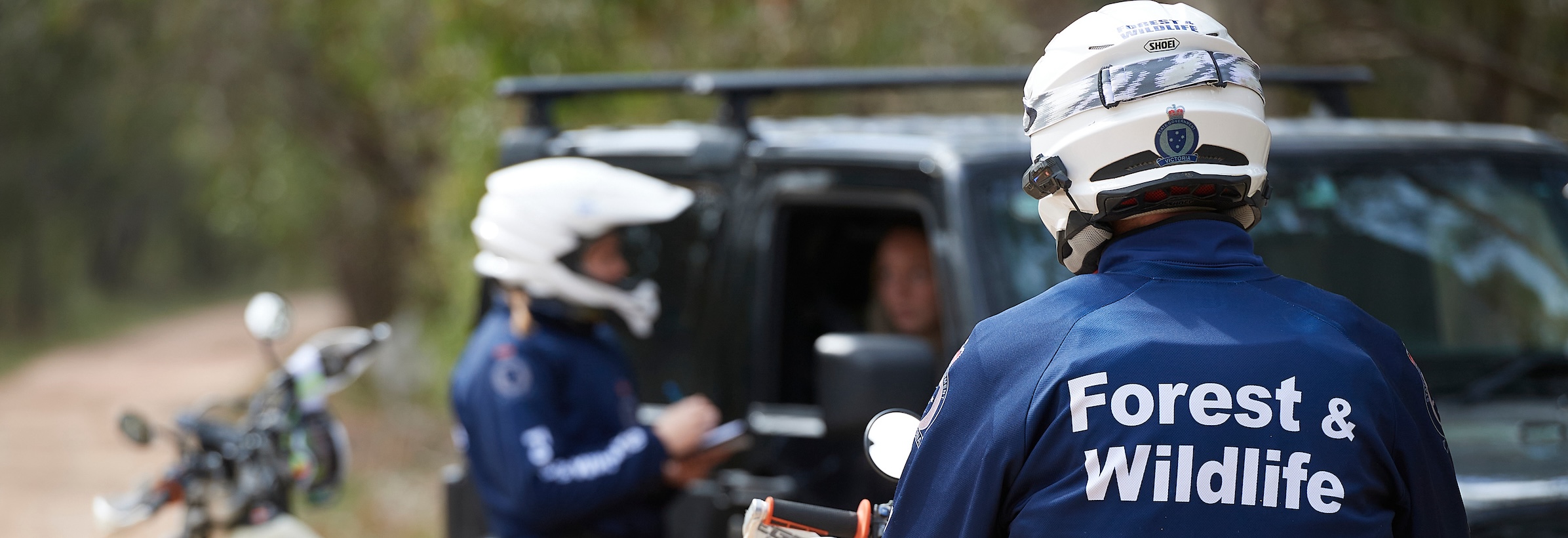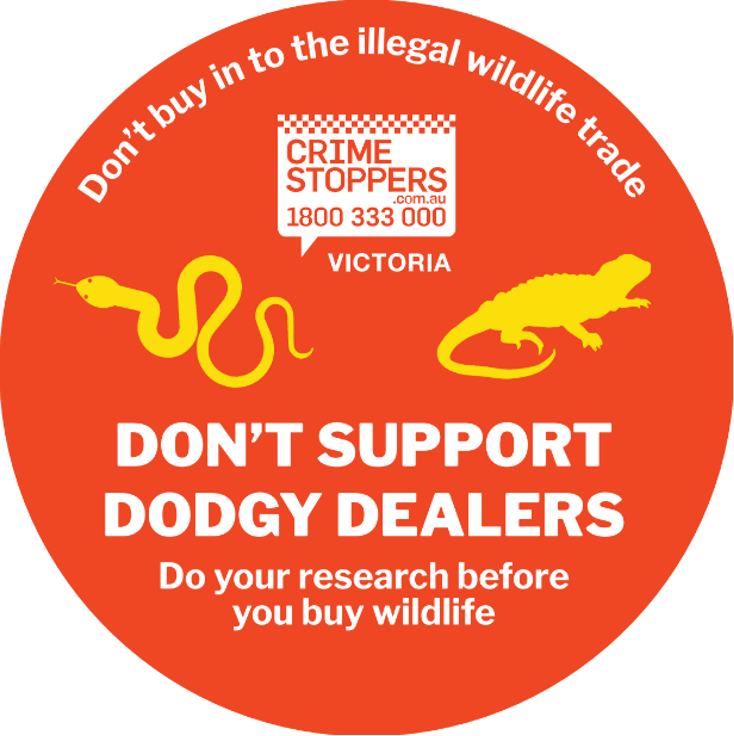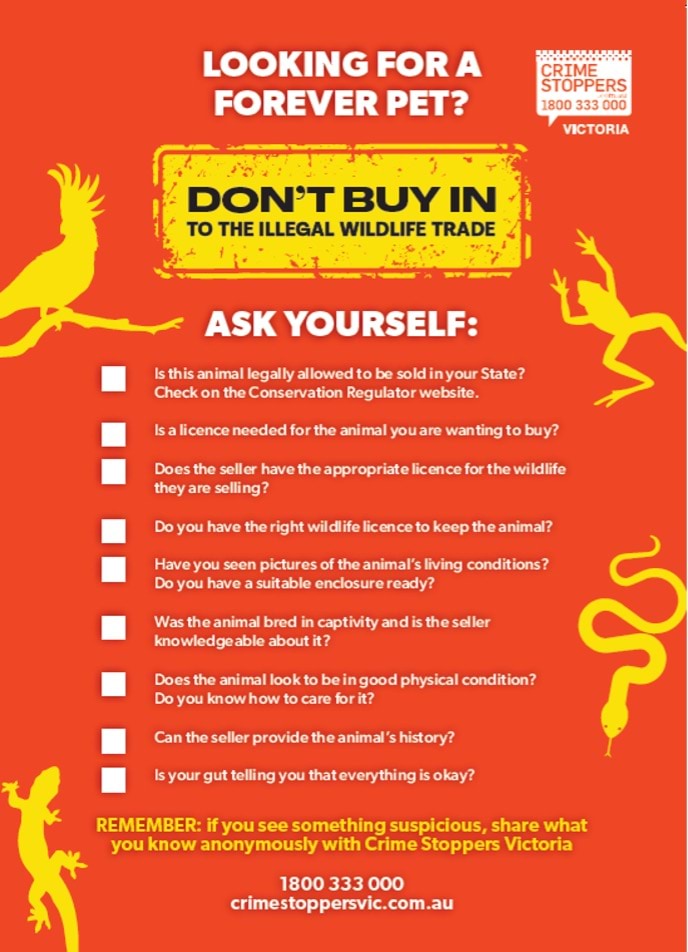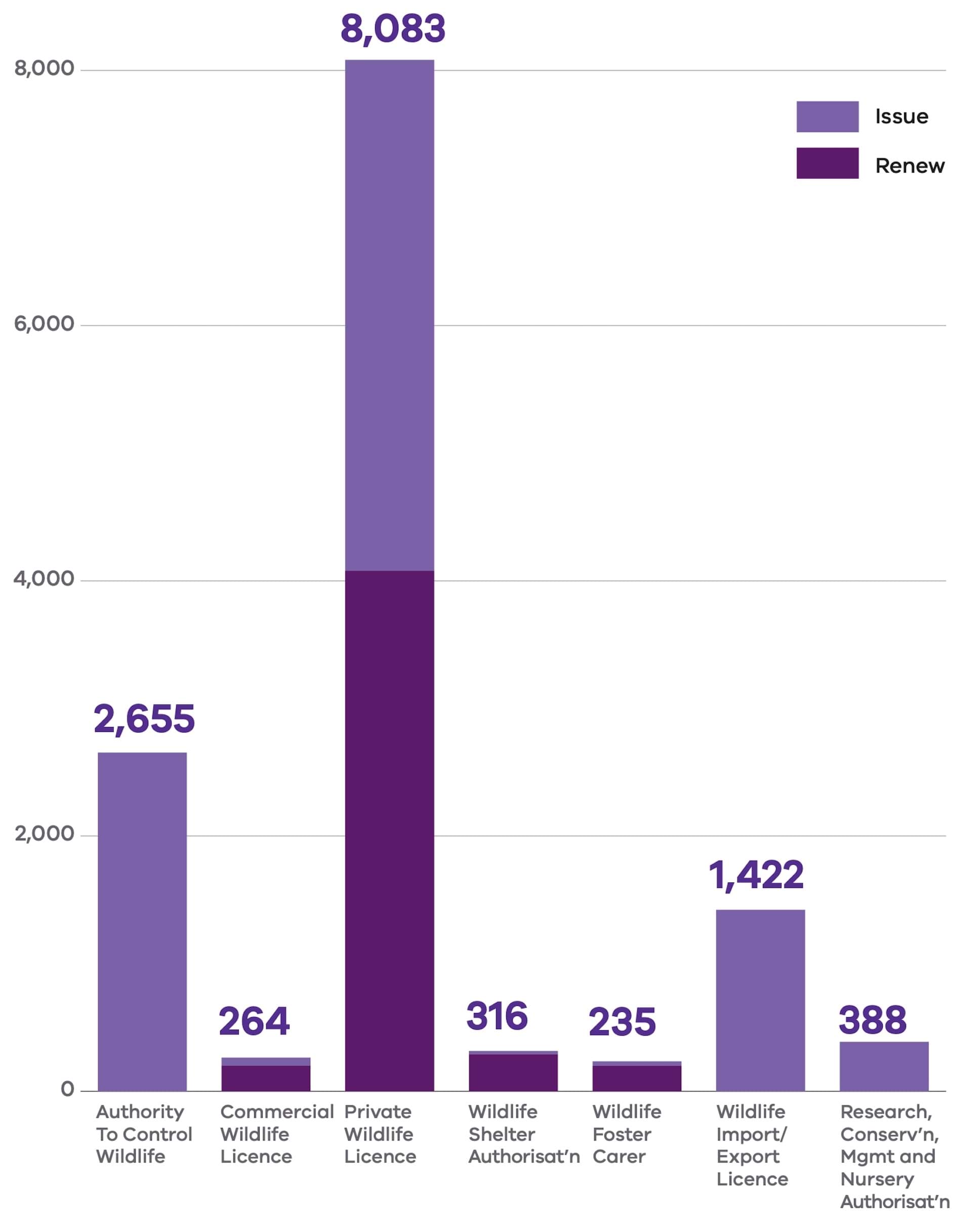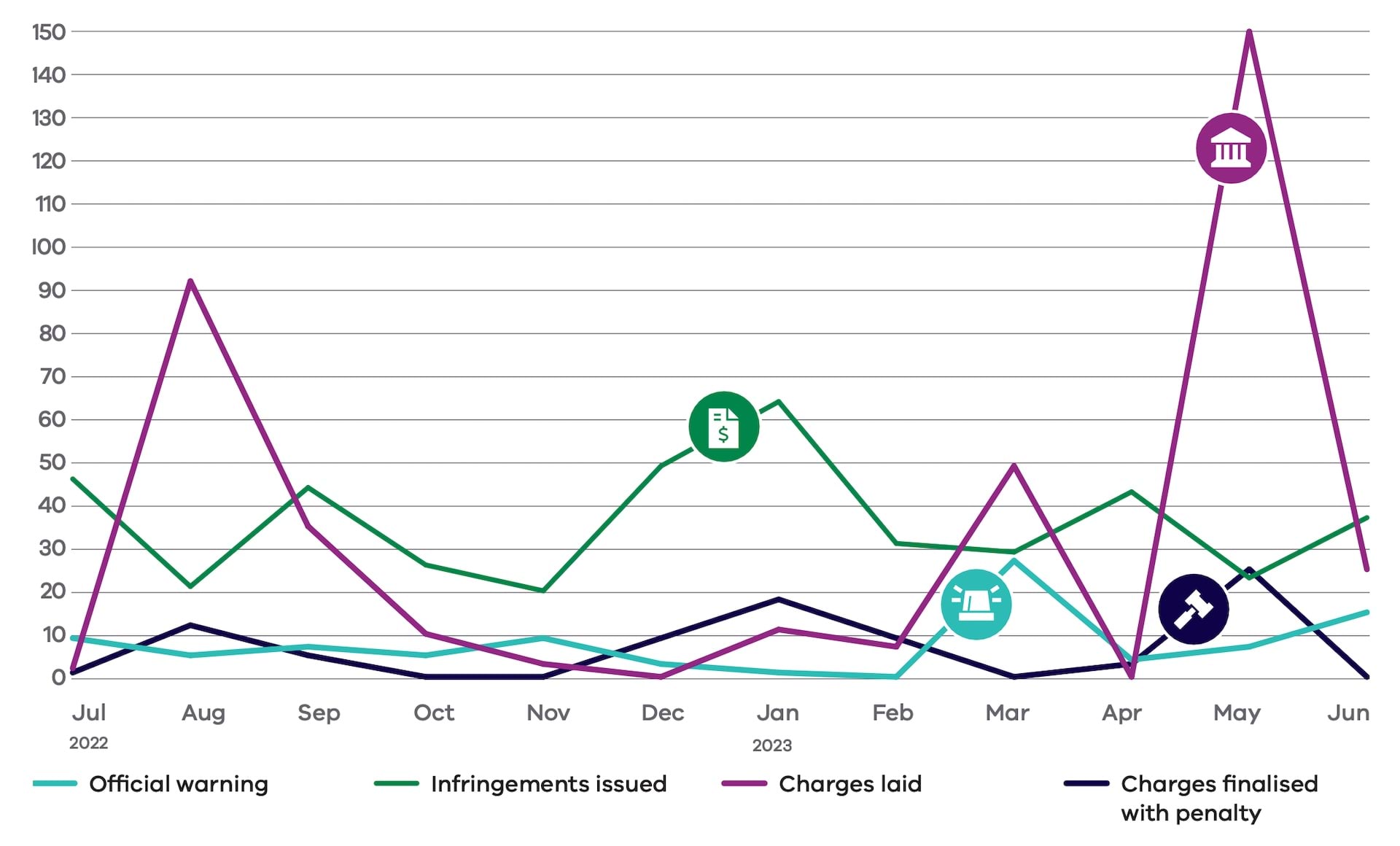2022-23 was another great year where we utilised our risk-based and intelligence-led approach, supported by strong community engagement, to ensure compliance with the law.

Illegal campfires
Bushfires can have devastating and lasting impacts, as Victorians know all too well.
This is why we continue to prioritise community safety and environmental protection by reducing the risks from illegal and unsafe campfires.
For the second year in a row, wet weather conditions brought by a La Niña event reduced the risk associated with unattended campfires, although the potential harm to communities and the environment from illegal campfires remained. Between July 2022 and June 2023, a total of 444 unattended or abandoned campfires were reported on public land, compared to 532 in 2021–22 and more than 800 in 2020–21.
Most illegal campfires were reported in the Hume and Gippsland regions, comprising 80 per cent of total detections. Peak periods of illegal campfires frequently lined up with holiday periods and long weekends, with 135 detections in January 2023 and 104 in April 2023 across the State. Authorised Officers issued 31 official warnings for campfire offences and 53 infringement notices. In September 2022, two prosecution cases were finalised relating to campfire offences that occurred on Total Fire Ban days in 2021–22. The outcome was an order for one of the accused to donate to the Country Fire Association and the other to pay a fine.
Since inception, the Conservation Regulator has focused and sustained its efforts to engage and educate communities about campfire safety.
During the 2022-23 summer, we partnered with Forest Fire Management Victoria to trial an educational campfire bucket initiative in the Alpine Shire region, designed to teach campers about safely maintaining and extinguishing their campfires.
Following positive feedback from the public, we are extending the initiative state-wide in 2023–24. By distributing reusable metal buckets branded with campfire information, we hope to reduce the bushfire risk from escaped campfires on public land.
Importantly, as we look ahead to summer in 2023-24, authorities have declared an El Niño weather pattern to form across eastern Australia, bringing warm, dry weather and increasing the risk and damaging effects of bushfires. The Conservation Regulator’s continued engagement with communities through patrols, messaging, and targeted campaigns will help raise awareness of campfire safety regulations and will be key to reducing the dire consequences illegal campfires on public land can have.

Illegal possession of wildlife
Victoria is home to a range of unique native animals, and whether being cared for in captivity, visiting our backyards, or roaming free on public land, they must be treated humanely, and obtained and traded legally.
Over the last 12 months, the Conservation Regulator continued its work in protecting Victorian wildlife by identifying, investigating, and prosecuting those responsible for wildlife crimes.
Unfortunately, many animals are unlawfully taken from the wild every year to be illegally traded, trafficked, and kept for personal use, and they are often subject to cruel conditions and transport methods. The removal of wildlife from their natural environments can also create significant and lasting damage to wildlife populations and habitats.
The Conservation Regulator relies on public information about suspicious behaviour or illegal activities to support our efforts to combat wildlife crime. Our partnership with Crime Stoppers Victoria and strong relationships with other wildlife agencies, including Zoos Victoria, Agriculture Victoria, and RSPCA are critically important for the Conservation Regulator’s work to effectively gather information, investigate, and reduce wildlife crime.
In 2022–23, the Conservation Regulator laid 146 charges relating to wildlife, including illegal possession, harm, and cruelty offences. In addition, four official warnings and 39 infringement notices were issued (This figure incorporates infringement notices issued by the Conservation Regulator as part of Operation SoHo which was a joint operation with Parks Victoria).
Educating the community about responsible ownership of wildlife has also become a focus for the Conservation Regulator, as our data continues to show a steady increase in license applications and many of the wildlife crime reports we receive relate to issues of neglect, rather than intentional cruelty. As such, the Conservation Regulator is continuing to help wildlife licence and authorisation holders understand the law and how to comply, through inspections, monitoring and guidance on our website.
Raising awareness of illegal trade of wildlife and exotic pests
Once again, we partnered with Crime Stoppers Victoria and Agriculture Victoria to raise awareness about the illegal trade of wildlife and exotic pests. In October 2022, we launched the Don’t Buy In campaign aimed at stopping people buying pets that have been illegally brought into the country or taken from the wild.
The coordinated campaign involved targeted messaging and advertising on social media and online marketplaces, such as Facebook and Gumtree, to educate buyers on how to legally acquire and keep wildlife, including information about types of animals and licences. Online marketplaces and social media have made the illegal sale of native animals easier. The Conservation Regulator is encouraging people to be prepared before buying wildlife and to be alert to dodgy dealers, so they can avoid inadvertently supporting the trade of illegal wildlife. Between July 2022 to June 2023, there was a 12.5 per cent increase from the previous year in wildlife crime reports made to Crime Stoppers Victoria. These reports help us to understand wildlife crime trends and conduct investigations. We thank the public for these reports and urge you to continue coming forward.
Operation SoHo
Operation Save our Hoodies (SoHo) is a coast-wide operation led by the Conservation Regulator which focuses on the protection of native hooded plovers (Thinornis rubricollis) during their crucial summer breeding season.
The operation, in its second season, is run in partnership with Parks Victoria and BirdLife Australia, and involves both educational and enforcement actions to support the survival of the threatened beach‑nesting bird.
Hooded plovers are currently listed as vulnerable under both the Victorian Flora & Fauna Guarantee Act 1988 and the Commonwealth Environment Protection & Biodiversity Act 1999. Environmental factors such as king tides, extreme heat events and erosion threatened the tiny birds, as well as significant threats from humans who risk scaring them off or trampling on their nests, and dogs which often catch and kill chicks.
From September 2022 to April 2023, Authorised Officers from the Conservation Regulator and Parks Victoria partnered with volunteers from BirdLife Australia to conduct 232 patrols along the Victorian coast, engaging with more than 1,570 people. The collaborative enforcement effort of Parks Victoria and the Conservation Regulator has resulted in 83 people fined for various offences, including disturbing nesting birds and owners not in control of their dogs in hooded plover habitat.
Another year of protection efforts under Operation SoHo has helped at least 40 (Estimated by BirdLife Australia) more hooded plover chicks fledge along Victoria’s coast, bringing the total adult population to approximately 750 birds.
- 1,570+ community engaged
- 83 individuals fined
Two men pay the price for illegal animal possession
In separate cases, two Victorian men were ordered to pay a total of $6,800 after Authorised Officers caught them illegally keeping snakes as pets.
In April 2023, a Nichols Point man was fined $1,000 and ordered to pay $4,600 in legal costs after he pleaded guilty to three offences related to the cruel treatment and illegal possession of an endangered Murray Darling Carpet Python. The fine followed a Conservation Regulator investigation last year, after the man’s landlord found the snake at his rental property housed inside an enclosure filled with faeces and no drinking water.
The snake was re-homed by the Conservation Regulator.
In another matter, a Nagambie man was convicted and ordered to pay more than $1,200 in fines and vet costs after Authorised Officers found him in possession of a two-metre-long boa constrictor in 2021.
The man pleaded guilty to one count of keeping a controlled pest animal without authorisation, an offence under the Catchment and Land Protection Act 1994. Authorised Officers inspected his house after receiving reports he was keeping a carpet python without a licence, but instead found what they believed to be a boa constrictor. Keepers at Zoos Victoria confirmed the species based on the size, markings, and colouration of the snake. Boa constrictors are native to South America and the Caribbean and are classified as a pest animal in Australia. Pest animals pose a serious threat to the environment and community health and can only be kept with certain licences.
- $6,800 penalty issued
Koalas at Cape Bridgewater
In December 2022, a harvesting contractor was fined $20,000 for their part in clearing koala habitat at a Cape Bridgewater property between November 2019 and January 2020, which impacted more than 200 koalas, 70 of which were injured and killed or had to be euthanised.
The contractor pleaded guilty to one charge under the Prevention of Cruelty to Animals Act 1986 for an act, which a Magistrate said likely could have caused unreasonable pain or suffering to that property’s koala population.
It was one of two businesses hired by the landowner to clear vegetation from the former operational blue gum plantation. The contractor used an excavator to remove stumps, some of which exhibited regrowth and that served as koala habitat, in a discrete part of the property. The contractor was responsible for a minority of the clearing at the property.
This court outcome follows a Conservation Regulator investigation into reports of injured and starving koalas at the Cape Bridgewater property in February 2020. In addition to the outcome above, the landowner and a separate forest and earthmoving business were charged in December 2021 with 126 offences each under the Prevention of Cruelty to Animals Act 1986 and the Wildlife Act 1975, including 18 aggravated cruelty charges for causing fatal injuries. Both cases are still before the Warrnambool Magistrates’ Court.
- $20,000 penalty issued
- 2 cases pending
Permits and licensing
Licences and permits help protect our wildlife and ensure that interactions with wildlife are careful, ethical, sustainable, and meet the requirements of the Wildlife Act 1975.
The Conservation Regulator issues many different types of wildlife authorisations, and applications from the public continued to trend upwards this year, with a 9.5 per cent increase in Private Wildlife Licences issued or renewed from 2021-22. Spikes in application numbers are often seen during school holidays and in the lead up to Christmas.
To make compliance simpler and easier, we have made improvements to the way we assess and issue authorisations, with a particular focus on digitisation. In early 2022, we began creating online forms for several types of licences, including applications for Import/Export permits, Private Wildlife Licences and Authority to Control Wildlife (ATCW) permits. Since then, more than 6,100 Private Wildlife Licences, 1,100 Import/Export Permits and 2,900 ATCWs have been applied for online.
Wildlife licence holders are required by law to keep up-to-date records of all wildlife in their possession. Each year, licensees must submit an Annual Return form to the Conservation Regulator which details any changes to their collections, including if animals have been acquired, traded, or have died.
This data helps us to understand what wildlife is being held and monitor any trends, such as high death rates or concentrations of dangerous species (such as venomous snakes).
Unfortunately, the compliance rate for annual returns has historically been very low, but this year the compliance rate increased by nearly 10 per cent, up from 47 per cent in 2021–22. We attribute this improvement to better communications and reminders from the Conservation Regulator about the importance of submitting a return, as well as the introduction of an online tool, with more than 6,700 licence holders choosing to submit their Annual Return digitally this year.
All licences and permits have conditions that help protect the welfare of any wildlife held in captivity. The Conservation Regulator provides information about permit holder obligations at the point of application and during renewals. We also publish guidance for permit holders online, including the Koalas in Blue Gums Regulatory Guide and the Rehabilitator Authorisation Guide. We work to monitor compliance with licence and permit conditions, and ensure any non-compliance is investigated.
Permits and licence types
There are many different type of licences and permits issued by the Conservation Regulator, which help ensure safe, legal, and ethical interactions between people and native wildlife.
Permissions that we are responsible for include:
Authority to Control Wildlife
Allows landholders and land managers who have issues with wildlife causing damage to buildings, pastures, crops, or other property, or which pose risks to human health and safety, to manage these problems. An authority may include permission for lethal and non-lethal control methods.
Commercial Wildlife Licence
Allows for the commercial use of wildlife, including selling wildlife in pet shops, keeping wildlife in zoos, as well as taxidermy and other processing of wildlife products.
Private Wildlife Licence
Allows people to keep wildlife at their private residences.
Wildlife Shelter Authorisation
Allows people to care for and rehabilitate injured, ill, or orphaned wildlife for release back into the wild.
Wildlife Foster Carer Licence
Allows people to care for and rehabilitate injured, ill, or orphaned wildlife for release back into the wild.
Research, Conservation, Management and Nursery Authorisation
Allows people to conduct research where activities may be impacting on wildlife, protected flora or fish, but are necessary for improving scientific understanding, such as attaching radio collars to track wildlife.
Forest Produce Licence
Allows individuals and private companies to cut, dig, or take away material from state forests for personal or commercial use. Two Forest Produce Licences were issued in 2022-23.
Statement of Regulatory Intent –Regulating the protection of Wildlife
The Conservation Regulator’s role and responsibilities in wildlife regulation are outlined in our Statement of Regulatory Intent – Regulating the protection of Wildlife.
The statement sets out how we regulate the protection, conservation, and activities concerning wildlife, including sustainable use and access. It also defines our public commitments and performance measures to help the community and regulated entities understand what they can expect from us as a regulator.
Performance measures for regulating the protection of wildlife
The following tables contain an update on each of the measures contained in the statement.
Permissions
Number of Wildlife permission by type issued.
| 2021-22 | 2022-23 | ||
|---|---|---|---|
| Authority to Control Wildlife | Total | 2,148 | 2,655 |
| Commercial Wildlife Licence | Total | 268 | 264 |
| Issue | 41 | 61 | |
| Renew | 227 | 203 | |
Private Wildlife Licence Including Dingo licence | Total | 7,377 | 8,083 |
| Issue | 3,436 | 4,004 | |
| Renew | 3,941 | 4,079 | |
| Wildlife Shelter Authorisation | Total | 257 | 316 |
| Issue | 16 | 25 | |
| Renew | 241 | 291 | |
| Wildlife Foster Carer Licence | Total | 246 | 235 |
| Issue | 68 | 34 | |
| Renew | 178 | 201 | |
| Wildlife Import/Export Permit | Total | 1,568 | 1,422 |
| Research, Conservation, Management and Nursery Authorisations | Total | 358 | 388 |
Sets standards, inform and educate, supporting compliance
| 2021-22 | 2022-23 | |
|---|---|---|
| Conservation Regulator publications | See Key publications | |
| Wildlife licence holders that submitted required Annual Return | 47% | 56% |
Monitoring compliance
| 2021-22 | 2022-23 | |
|---|---|---|
Licence, permit and property inspections. Conduced to determine compliance with conditions. | 148 | 298 |
Enforcement of the law
In response to non-compliance, in line with Conservation Regulator Compliance and Enforcement Policy for Wildlife.
| 2021-22 | 2022-23 | |
|---|---|---|
| Infringement Notices issued | 28 | 39 |
| Official warnings | 3 | |
| Prosecution charges laid | 18 | 127 |
Collaborate
| 2021-22 | 2022-23 | |
|---|---|---|
| Number of calls and emails received and assessed by our Customer Contact Centre concerning wildlife | 4,645 | 5,148 |

Illegal commercial timber harvesting
The Conservation Regulator is responsible for regulating commercial native timber harvesting in state forests.
We utilise a multi-faceted regulatory approach to ensure the timber industry complies with the law and involves undertaking proactive inspections, audits, and investigations, gathering intelligence, and responding to reports of non-compliance.
The approach undertaken and outcomes for 2022–23 are detailed further in Regulating timber harvesting.

Illegal take of firewood
The illegal take of firewood for personal use or commercial sale risks the survival of many of Victoria’s native mammals, reptiles, birds, and the health of important ecosystems.
Victoria has two domestic firewood collection seasons per year, in autumn and spring, in which the Victorian community can collect firewood from designated firewood collection areas legally and for free. There are strict rules around the type and amount of wood that can be collected to preserve wildlife habitat and protect community resources.
The Conservation Regulator continued to target illegal firewood activity in 2022–23 through forest patrols, concealed cameras, and other methods to detect offences, and engaging with the community through the media and other channels to support compliance. We laid 109 charges related to the illegal removal of firewood from Victorian public land.
Across the state, reports and direct observations of illegally felled trees and subsequent timber removal, primarily for the purposes of firewood supply, have significantly increased across DEECA and Parks Victoria managed estates. Many public land areas, particularly those with desired firewood species such as River Red Gum, are being left devoid of standing, dead trees. River Red Gum is typically found along water courses and floodplains and old, standing dead trees provide important habitat for tree dwelling mammals, birds and reptiles that rely on hollows for shelter and nest sites.
The formation of hollows in eucalypt species takes decades to occur and the removal of these trees diminishes the ability of these public land spaces to provide important habitat for Victoria’s native wildlife. The Conservation Regulator will continue to direct and focus its efforts and resources to reduce the impact this illegal activity has on the conservation values of Victoria’s public land.
Reports of illegally felled trees and timber theft have increased significantly over the past five years, largely in Victoria’s colder months. Cost-of-living pressures have increased demand for firewood, while wildlife populations and ecosystems are particularly vulnerable after recent extreme weather events. The Conservation Regulator continues to direct effort towards addressing these concerning risks to wildlife and ecosystems.
Operation River Gum
Operation River Gum was our dedicated firewood operation focusing on the detection, investigation, and prosecution of illegal firewood offences in areas of highest environmental concern along the Murray River corridor in the Loddon Mallee and Hume Regions.
The operation was designed and led by the Conservation Regulator in partnership with DEECA Forest and Fire Operations Division and Parks Victoria. It utilised traditional regulatory activities, such as patrols and penalties, and tested some novel approaches to community engagement to educate them on the impacts of illegal firewood collection.
While the on-ground operations concluded in November 2022, many of the offences detected were finalised in court in 2022–23. The Conservation Regulator has so far brought charges against 17 people and finalised six cases in court with penalties including criminal convictions, fines between $1,000 and $7,500, and forfeiture of various seized items to the Crown. Authorised Officers also issued an additional 37 infringement notices for various offences related to illegal firewood removal.
We also trialled additional methods to engage with buyers and sellers of firewood in Victoria to inform them of the impacts of illegal firewood collection. We sent a direct mailout to 87 firewood sellers and ran an online advertising campaign on Facebook Marketplace and Gumtree targeting potential firewood buyers, which reached 1.2 million people.
- 1.2 million community members engaged
- 17 accused prosecuted
- 37 penalties issued
South Australians fined for firewood offences in Victoria
Three South Australian men were fined a combined total of $4,810 for illegally cutting and taking four cubic metres of red gum trees for firewood from the Nangeela State Forest in September and October 2022.
Two of the men received infringements for illegal off-road driving under the Land Conservation (Vehicle Control) Regulations 2013, while all three were fined for cutting and taking the timber, a breach of the Forests Act 1958.
Conservation Regulator Authorised Officers caught the men, all aged in their 20s, on concealed cameras installed near the border to help target illegal firewood operations.
- $4,810 penalty issued
Convictions and fines for Goulburn Valley firewood thieves
Two men from the Goulburn Valley were convicted and fined a combined amount of $12,500 in January 2023 after they admitted to illegally cutting and taking timber from the Lower Goulburn National Park and the Loch Garry Wildlife Reserve.
One Congupna man pleaded guilty to 11 charges relating to disturbing wildlife habitat, illegal firewood collection, illegal off-road driving and obstructing an Authorised Officer in the execution of their duty. The Presiding Magistrate also ordered the destruction of the man’s two chainsaws and dual trailer.
The Shepparton man, who has previously been convicted of similar offences, pleaded guilty to three charges of illegally cutting timber, disturbing wildlife habitat, and driving off-road.
Conservation Regulator Authorised Officers detected the pair after they were captured on concealed cameras installed as part of Operation River Gum.
- $12,500 penalty issued

Illegal vehicle use
Trail bike riding and four-wheel driving has increased in popularity since the COVID-19 pandemic, and while they are good ways to explore Victoria’s great outdoors, there are strict rules about where vehicles can go to protect drivers, riders, and the environment when out exploring.
The Conservation Regulator targets illegal vehicle use on public land because of the serious risks it poses to sensitive ecosystems, cultural heritage, and personal safety. This includes activities related to the construction of illegal training grounds, such as illegal campfires and littering. Illegal vehicle use remained the most common offence category in 2022–23. Authorised Officers issued 167 infringement notices and 28 official warnings to four-wheel drivers and trail-bike riders for off-road-related offences, including using roads closed to the public or illegal single trails. Nearly 50 per cent of vehicle-related offences and observations were made in the Hume region. Many major 4WD and off-road motorcycle events, trade shows, races, and rallies returned following the end of pandemic restrictions, and the Conservation Regulator was able to use these events as opportunities to engage with and educate the community.
Operation sprocket
Operation Sprocket is a state-wide operation led by the Conservation Regulator that educates recreational trail bike riders on how to ride safely, legally, and sustainably on Victoria’s public land.
The operation completed its third year during 2022-23, with a continued focus on promoting personal safety and environmental protection to the state’s community of approximately 60,000 licensed trail bike riders. Trail bike accredited Authorised Officers attended several off-road events and recreational trail bike rallies, engaging with more than 3,600 riders to raise awareness of safe riding behaviours, protective equipment, and Personal Locater Beacons (PLBs).
Over the past three years, trail bike riding has increased significantly in popularity, with off-road motorcycles making up nearly half of all motorcycle sales in 2022. Sadly, more than 30 per cent of Victoria’s reported motorcycle accidents occur in state forests and parks, and riders increase both their risk of injury and significant environmental damage if they illegally leave formed roads on public land.
The Conservation Regulator’s Trail Bike Safety Initiative works in partnership with Victorian motorcycle associations and road safety authorities to actively engage with and influence the behaviours of off‑road motorcycle riders to reduce the amount and severity of crashes, as well as their environmental impact.
- 3000+ riders engaged
Bairnsdale man pays the price for off‑road environmental damage
A Bairnsdale man was convicted and fined $1,500 in September 2022 for two illegal off-road driving offences he committed in the Nunniong State Forest in October 2021.
The man pleaded guilty to forcing open and damaging a seasonal closure gate and driving on a closed road in a sensitive alpine area. The Presiding Magistrate also ordered the man pay $244.86 in additional legal costs.
- $1,500 penalty issued
Figure 3 provides a month-by-month breakdown of the number of warnings and penalties issued and the number of accused prosecuted.
Man faces 100+ charges over northeast land clearing
The owner of an earthmoving business was charged with 127 offences relating to illegal native vegetation clearing and habitat destruction after allegedly bulldozing more than 60 large native trees on public land in and around the Mount Lawson State Park in April 2022.
Conservation Regulator Authorised Officers investigated following a report of large machine tracks and alleged illegal land clearing behind private property that adjoins the park.
Environmental experts assessed the site and found the felled trees would have provided significant habitat for native wildlife, including the endangered gang-gang cockatoo, and the damage will have lasting impacts on biodiversity values.
As the regulator of public land in Victoria, it’s our responsibility to investigate and, where appropriate, prosecute cases of illegal native vegetation removal on Crown land.
- 127 charges laid
Key publications
We published several documents during 2022–23 to help community and industry members understand where we focus our efforts and how they can support compliance. These publications are critical to meeting our regulatory responsibilities, and by providing appropriate guidance we can prevent harm from occurring in the first place.
Regulatory Priorities for 2022–23(opens in a new window)
The updated annual Regulatory Priorities for 2022–23 outlined our state-wide priorities and recognised the unique context and compliance risks facing Victoria’s environments.
Wildlife Rehabilitator Authorisation Guide(opens in a new window)
Wildlife rehabilitators are regulated by conditions that enforce the minimum standards required for the humane treatment and successful rehabilitation of wildlife in care. This authorisation guide explains the conditions of authorisation, and the objectives of each condition to assist authorisation holders to comply.
Injunctions, Enforceable Undertakings and Statute of Limitations for commercial timber harvesting offences (opens in a new window)
The Conservation Regulator was established to oversee key regulatory functions including the compliance and enforcement of timber harvesting in State forests. The website was updated to clarify the use of available regulatory tools for timber harvesting offences, including injunctions and enforceable undertakings. In addition, guidance was published explaining amendments to the statute of limitations and how this may impact enforcement action for timber harvesting offences.
Conservation Regulator brochures
- Can I? Can’t I? Campfires and barbecues
- Can I? Can’t I? Vehicle use on Victorian public land
- Can I? Can’t I? Domestic firewood collection from Victoria’s public land
- A guide to boating and swimming around whales, dolphins, and seals
Upgrades to our systems and processes
We are always looking for ways to improve our systems, processes, and tools, to enable more effective and efficient regulation. Since being established, the Conservation Regulator has been working to progressively procure and implement modern business systems, including digitising regulatory interactions where appropriate to reduce unnecessary paperwork and the associated delays.
2022-23 initiatives
Licensing system
- We are now turning our attention to procuring a new licensing system to further improve the administration and the digitisation of our licences and permits.
- Underway
Case management system
- In 2022-23, developing a new Case Management System has been the Conservation Regulator’s priority. The Case Management System will be implemented in 2023-24.
- Underway, due quarter 2, 2024
Intelligence system
- Our new regulatory intelligence database commenced in 2021. We continue to refine and improve the intelligence database.
- Complete
Digital application forms
- Digital application forms for most regulatory licence and permit applications, inclusive of annual returns that are required to be submitted each year by Wildlife Licence holders, were introduced in 2022-23. Digital application forms have reduced time between application submission and issue of private wildlife licences from an average of 21 days in 2018 to an average of 10 days in 2022.
- Complete
Working together to achieve outcomes
Our focus on engagement
Engaging with the community is a key part of education, supporting compliance, and understanding what the community values and expects. In 2022-23, the Conservation Regulator attended numerous events to engage with the community, stakeholders, and other public land authorities across our regulatory priorities.
We appreciate any opportunity to meet members of the community to discuss our role and talk to them about how they can help protect Victoria’s environment and native wildlife.
2022-23 highlights
Outdoors Victoria conference
An opportunity to engage with outdoor recreational operators and educators and talk to them about what we do, why it’s important, and how we can work together to protect our forests, including how to report any non‑compliance.
Phillip Island Whale Festival
Attending and presenting at the Phillip Island Whale Festival to help people better understand how to share the water with whales and other marine mammals safely.
Great Southern Bird Expo
Attending the Great Southern Bird Expo which provided a great opportunity to engage with wildlife licence holders and educate the public on the rules and requirements of keeping native birds as pets.
Arborist Festival
Speaking at the Arborist Festival on the legislation and regulations relevant to arborists, and the importance of managing wildlife while completing their work.
Crime Stoppers Victoria
Multiple Crime Stoppers Victoria events, including university orientation weeks.
Schools and universities
Numerous school visits and university presentations.
Operation Leonina
By the time an elephant seal settled on a quiet beach on the Mornington Peninsula for a few weeks to rest and moult his winter coat in January 2023, he had already built quite the fan-base after making international headlines for his escapades across the bay at Point Lonsdale.
Affectionately named Henry, the juvenile elephant seal made a temporary home and routine at the beach at Camerons Bight and with no signs of him leaving, the local land manager Whitecliffs Foreshore Reserve Committee of Management decided to close the area to make sure crowds kept their distance and Henry could rest peacefully.
As interest in the elephant seal’s behaviour and welfare increased, the Conservation Regulator led protection efforts under Operation Leonina and partnered with the Foreshore Reserve team, Forest Fire Management Victoria, and Peninsula Security Services for round-the-clock education and enforcement action. The Marine Response Unit, Melbourne Zoo, Mornington Peninsula Shire Council, and Victoria Police also helped manage the situation.
On 15 February, we said goodbye to Henry as he began his journey south and the beach was reopened to the public.
A huge thank you to all teams involved!
Updated
